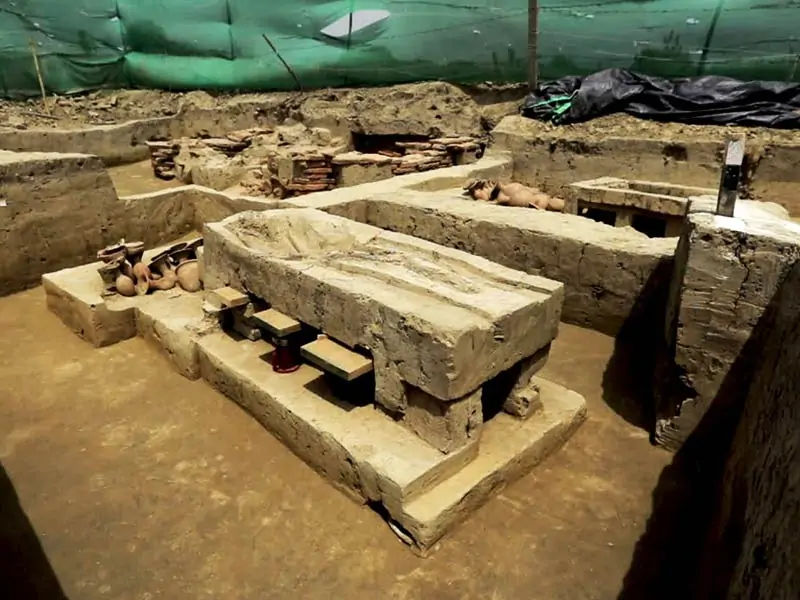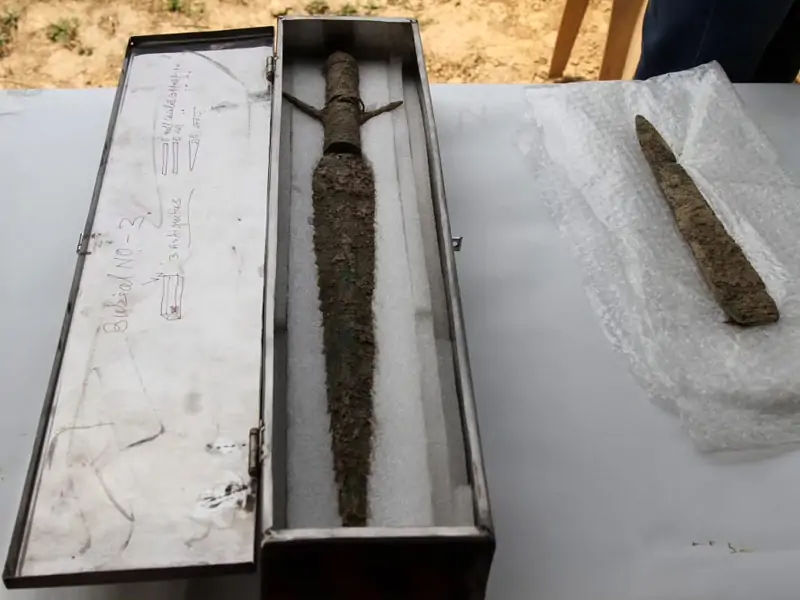Sinauli: The Discovery of Forgotten India
Shortpedia
Content Team
Sinauli is an archaeological site discovered in Uttar Pradesh's Baghpat district. The site discovered ties to early Vedic Age Civilizations that might be related to the Mahabharata or Ramayana. Take a peek at the post to find out what makes this site distinctive.
Why is Sinauli making headlines?
Sinauli has lately been in the headlines due to a new Discovery Channel documentary centered on this minor archaeological site. This location has yielded evidence of the presence of a warrior class dating back to about 2000 BCE.

Archaeologists from the Archaeological Survey of India (ASI), led by Dr. Sanjay Manjul, excavated Sinauli in 2018. He uncovered 116 graves there. As of the present, it is Asia's biggest excavated burial site. It was the first antique chariot unearthed in Bharatavara. This chariot was built between 2100 and 1900 BCE.
Sinauli, where are you?
Sinauli is a town in the Indian state of Uttar Pradesh's Baghpat district. It is located 70 kilometers from New Delhi, near the confluence of the Ganga and Yamuna rivers.
About Sinauli

Sinauli is an archaeological site in the tehsil of Baraut in the district of Baghpat in western Uttar Pradesh, India.
The site is well-known for its Bronze Age "chariots," which were the first to be discovered during an archaeological dig in South Asia.
According to local mythology, Sinauli is one of the five towns where the deity Krishna unsuccessfully pleaded with the Kaurava kings to avert the Battle of Kurukshetra.
ASI performed the excavations in 2005-06 and again in mid-2018.
According to ASI and subsequent research, the bones discovered in 2005-06, the "Sanauli cemetery," dated the Late Harappan Phase.
Excavation 1.0 at Sinauli in 2005:
The excavations began in 2005, and 116 burial sites were identified within a year. As a result, throughout the Chalcolithic period, it was regarded as India's largest known necropolises.
The burial sites differ from those of the Indus Valley Civilization. The coffins stand on four legs, and the tombs include underground rooms.
Vases, bowls, and pots are discovered methodically piled beside the body in the graves.
Rice was discovered in the buried pots beside the remains of the troops.
During the excavation of one coffin, 8 anthropomorphic figurines (human-like figures) were discovered.
One remarkable feature is that the graves resembled Vedic civilization rather than Indus Valley culture.
Cloth impressions on the bodies imply corpse cleansing, as performed in Hindu rituals today.
Sinauli Excavation 2.0 in 2018:
It was brought to light again in 2018 when a farmer reported discovering artifacts while plowing the area. According to the Hindustan Times, the farmer discovered copper fragments in the ground, prompting the ASI to intervene.
In 2018, what was discovered in Excavation 2.0?

The ASI began the dig after receiving reports of copper antiquities.
They discovered horse-drawn chariots that were about 5000 years old. The discovered chariots feature a fixed ankle connected to a tiny yoke through a long pole. This ankle, chassis, and wheel are reminiscent of current chariots. Animals, particularly horses, are supposed to have drawn these chariots.
Many weaponry, such as copper antenna swords, battle shields, and so forth, were discovered.
This time, they also discovered wooden foreleg coffins, as well as ceramics.
A whip used to signal the animals was also discovered, implying that the people who resided here had control over the animals.
Female warriors, like male soldiers, have been discovered buried with their swords.
Their legs around the ankles, however, had been removed before they were interred.
The terrain is predicted to be fertile and agriculturally appropriate. The excavation suggests the presence of a vast monarchy here.

The pottery discovered here is of the Ochre Colored Pottery (OCP) culture. This civilization is related to Harappan culture yet differs in several ways. The OCP culture was discovered in the late mature Harappan civilization.
Carbon Dating of the Items: The carbon dating of the objects revealed that they were 3800 years old. This indicates that the civilization existed in 1800 BC.
Carbon dating was performed at the Birbal Sahni Institute of Palaeosciences in Lucknow. The C-14 dating method was employed.
The human remains were examined by Deccan College in Pune, and the DNA study was carried out by a facility in Hyderabad.
The significance of the excavation
Because the items date from the late mature Harappan era, they potentially offer insights into the fall of the Indus Valley Civilizations.
There is still a very weak relationship between the Late Harappan, Chalcolithic, and Vedic eras. The excavations hint at these connections.
A warrior class between 2000 and 1800 BCE piques historians' curiosity and provides a glimpse into early Hindu society.
The woman warriors of Sinauli, India's forgotten history
In modern India, we are immersed in fighting about feminism, gender equality, and women's empowerment in every aspect of our culture. In a recent decision on giving permanent commission to women in the Indian army, the Supreme Court of India stated, "the structures of our society have been built by males and for males." Our women still prove their capacity to fight with men in the twenty-first century when we proclaim ourselves a contemporary civilization that the world has never seen before.

Was this always the case for women when we look back at our country's prior civilizations? History contradicts the common perception of women's frailty. Would you believe me if I told you that women fought alongside men in battle four thousand years ago? Would you believe it if I told you they rode on chariots? Would you believe it if I told you they were skilled archers and swordsmen? No, I'm not referring to the island of Themyscira, where the Olympian gods used to make women worriers. I'm referring to women who, in actuality, fulfilled the role of soldiers.
The most significant find of this dig was three chariots, all of which were discovered in two graves. Chariots were discovered for the first time in India. Many preconceived assumptions about ancient Indian civilizations were revised as a result of this finding. Previously, it was thought that chariots arrived in India considerably later when a troop of Central Asians or Europeans conquered the country. The renowned Aryan invasion hypothesis could not be proven in this case since no Central Asian or European component was identified in the skeletal remains of the graves, even though these skeletons bore striking resemblances to modern Indian ancestors.
Several artifacts, including potteries, beads, jewelry, pots, utensils, and other personal items, were commonly found in these graves. A huge number of copper antenna swords were uncovered. Weapons like shields and swords were discovered in female graves. An imprint of a bow and four arrowheads were recovered in one of the female graves. All of this suggests that women in ancient society were likewise proficient with swords and archery.
